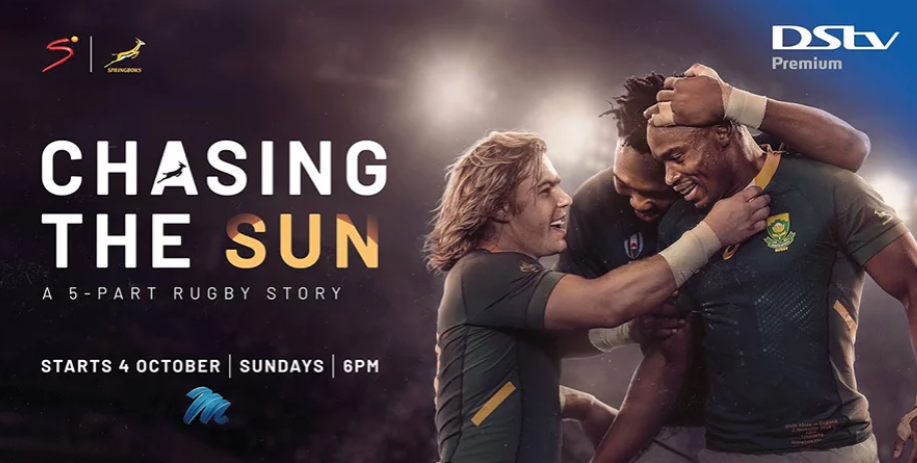The executive producer of the Springboks’ 2019 World Cup documentary, Gareth Whittaker, says its teasers are just a hint of what is in the final product. DYLAN JACK reports.
The first episode of the five-part documentary based on the Springboks’ 2019 World Cup victory, ‘Chasing the Sun’, will be aired on DSTtv this Sunday, 4 October. The final episode of the series will premier on 1 November, exactly one year since the final in Yokohama.
A SuperSport camera crew travelled with the Boks for the duration of 2019, getting unprecedented behind-the-scenes access throughout the lead-up to and during the World Cup in Japan.
ALSO READ: October release for Springbok World Cup documentary
With unique access and exclusive contributions from coaching staff, players and commentators, the documentary tells the story of how a team, a nation and the world came to discover that we are all indeed stronger together.
During the online media launch of the documentary on Wednesday, executive produce Whittaker explained the behind-the-scenes process that went into making the documentary.
‘It is the greatest privilege of my life,’ Whittaker said. ‘What a story to tell. I spent the last four months learning from watching, listening to guys like Pieter-Steph, Rassie and Beast and Siya, tell the story about what is the most wonderful journey South Africa has ever embarked on. It really is just the greatest privilege. I hope everyone absolutely loves this TV show. I spent many days in my office crying, because it is very emotional. It is a really cool story with really cool people.’
The documentary begins when the Springboks were experiencing one of the darkest periods of their history in 2016 and 2017, with the SuperSport crew entering the team environment under Rassie Erasmus way before the 2019 World Cup.
‘The process unfolded a little bit,’ Whittaker explained. ‘The interesting thing is the SuperSport team and guys saw this opportunity. It is a real credit to their vision. They saw the opportunity to tell the story of the Springbok team so far in advance.
‘Way before the idea of a series or documentary series was conceived, Gideon Khobane [SuperSport CEO] and [head of marketing] Mark Jury realised that being within the Springbok team would be hugely valuable. Way before we were involved, they sent a SuperSport crew into the team and into the change room. That was the crew that was there all the way through to the final. When they then came back, they had terabytes and terabytes of footage and data. We then said, “How can we help you to tell this story?” To the SuperSport team’s credit, they must have had a premonition that this thing would be of value.
‘When it began, I am not sure that the plan was for a five-part rugby story. The original plan was: this was a special team with a special culture, let’s go and get exclusive access to this team. That’s how it began. After the World Cup we sat down and said, “Holy smokes, we have got something special here. Let’s turn it into a documentary series.” And we began the production process from there.’
Whittaker explained that with the amount of footage and data that the production team had, they had to make some tough decision over what to include and what to leave out of the documentary.
‘It was tough to know what to leave out, actually. What we did after the World Cup, there is a bunch of storytelling elements. The first is this unbelievable behind-the-scenes access, which was just remarkable. As fans, you don’t get to sit inside the change room while Rassie gives a team talk, ever. So we had that.
‘But then when the team came back we sat down with each of the players, with a bunch of the management team and we did extended interviews from their point of view. Some of those interviews went on for ages, I think Rassie’s was eight hours long. The whole documentary is less than five hours. So there is a huge amount on the cutting-room floor. We wanted to be able to tell the story as authentically as possible from as many viewpoints as possible. We tried to get different people who were part of the story to tell it.
‘One of the driving principles we wanted to uphold in telling this story was authenticity. We wanted to authentically reflect the story. Another principle was drama. We want this to be something that keeps people on the edge of their seats and keeps people coming back for five episodes. That’s the way you end up making decisions.’
WATCH: Introducing Mapimpi – Chasing the Sun teaser
One of the fears raised about the structure of the documentary was that it would mostly consist of post-World Cup interviews with the coaching staff and players.
However, Whittaker assured Springbok fans that the documentary was constructed in an engaging way, that would keep them interested in all five episodes.
‘I saw someone on Twitter saying, “I hope this isn’t just interviews”. It really isn’t just interviews. There is a bunch of components. We have this bank of interviews where the players tell the story from their point of view. But we also got unbelievable access to the change rooms and to planning sessions and even to conversations among players. You really will see stuff that you have never seen before. Rassie’s Twitter page and his Instagram handle is just a tiny taste of what’s to come.
‘We also see a lot of South Africa. We travel to people’s homes, meet their families, see a bunch of different faces in South Africa. So it really is a good mix. Episode one has probably got the least behind the scenes because it started to gather momentum from episode two onwards. There is lots to come and there is a very good mix.’





